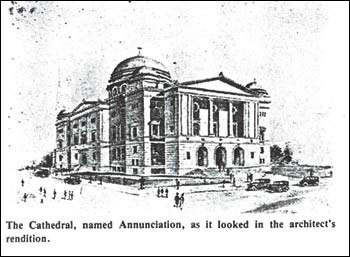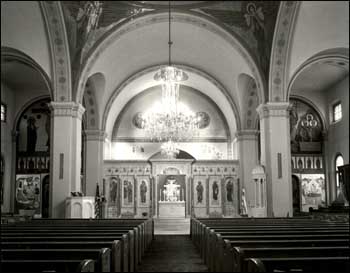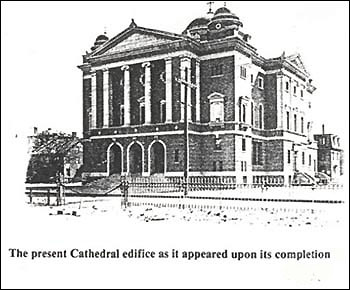The Historic Boston Greek Cathedral -- Reliving 100 Years
VIEWING THE CATHEDRAL ARCHITECTURE AND INTERIOR
The Cathedral architecture is in the classic Byzantine style with a large central dome surrounded by four smaller domes, one of which bears a large bell. This design is common to such well known Byzantine examples as Hagia Sophia in Istanbul, and the monasteries of Daphne and Hosios Loukas in Greece. The church proper has the traditional shape of the Greek cross. The interior architecture is dominated by a large central dome, vaulted ceilings with soaring arches connected by pendentives, and supported by large pillars capped in classic Greek design. A parking courtyard of paved stones in mosaic pattern and a handicap accessible elevator enhance the Cathedral's uniqueness.
One enters the Cathedral through impressive large bronze doors having Byzantine iconography which lead to the lower Narthex (vestibule). Here one is greeted by a shrine with a beautiful mosaic reproduction of the famous "Deisis" (Saint Sophia) in Istanbul, portraying Jesus Christ flanked by the praying Virgin Mary and John the Baptist. Standing in front we find a marble candle stand surrounded by several icons and, to the left, office space. Two doors open to the Fellowship Hall featuring a quaint St. Iakovos Chapel with a decorative stained glass window of Jesus being baptized viewed by two angels, a reception room, several Sunday School classrooms and a stage.
 Michael Anagnostopoulos
Michael Anagnostopoulos
|
Ascending two richly carpeted stairways to the upper Narthex, one finds large sparkling walled mosaics of the Nativity and Annunciation. To the rear of the Pangari (table with candles) are three stained glass windows of the "Resurrection, Annunciation and Nativity." Here the faithful light and place candles in bronze candle stands and venerate icons prior to entering the Nave (main worship area). The Nave's splendor is magnified by such distinctive features as stunning crystal chandeliers and radiant stained glass windows with vivid colors and a Byzantine motif. Above, one views a beautiful dome of angels and prophets painted on gold leaf pendentives and a cross inscribed at its central focal point with "En Touto Nika" ("With This Sign, Conquer"). This image represents the apparition which appeared to the Emperor Constantine before his victory over Maximus in 312 A.D.
Enhancing the Nave's esthetic nature are various marble features—the Solea (beginning of the Sanctuary), Ikonostasis (altar partition), Sanctuary floor and the Holy Altar table. To the right of the Ikonostasis, we find an elaborate marble Episcopal Throne, and a specially designed Aolean Skinner organ in the chanting and choir area. On the back wall is a full-length original wall artwork of "The Resurrection" with other significant icons below. To the left of the Ikonostasis, a wall painting of the "Crucifixion," with "Christ's Decent to Hell" on the right. Other icons overlook a pulpit adorned with mosaic icons of the Evangelists -- Matthew, Mark, Luke and John -- and, to the rear, an impressive marble Baptismal Font.
The upper Ikonostasis is adorned with brilliant mosaic icons of the Last Supper and Faces of the Twelve Apostles. From the left, in standard pattern below, are mosaic icons of the Archangel Michael, the Annunciation, the Theotokos (Virgin Mary) holding the infant Christ and the Royal Gates, designed with an impressive Byzantine motif. These are followed by mosaic icons of Jesus Christ, St. John the Baptist and the Archangel Gabriel. A mystically lighted Sanctuary features the Holy Altar table upon which is found a radiant gold-plated Artophorion (containing the Holy Eucharist), the Gospel Book, and the Vigil Light reminding us of "the constant presence of Our Lord in the world." Behind the Altar stands a large Crucifix reminding us of "Christ's sacrifice for mankind." Other items found in the Sanctuary are the Table of Oblation (used to prepare Holy Communion) and a Synthronon (Episcopal Throne).
Looking down from the arch above the Sanctuary is an eye-catching icon of the Pantokrator (Christ as the ruler of all) with hand raised blessing his creation from Heaven. On the Apse (rear wall of the Sanctuary), one gazes at a full-length icon of the "Platytera" (Virgin Mary) with the Christ child on her lap welcoming worshippers with outstretched arms. Below this, on each side, are frescoes of "The Twelve Disciples" depicting "The Feast of Pentecost."
When leaving this magnificent beacon of Greek Orthodoxy, one is left with a deep sense of spiritual awe for its many classical Byzantine features, and an appreciation for its historical significance.
History of the Cathedral
|




